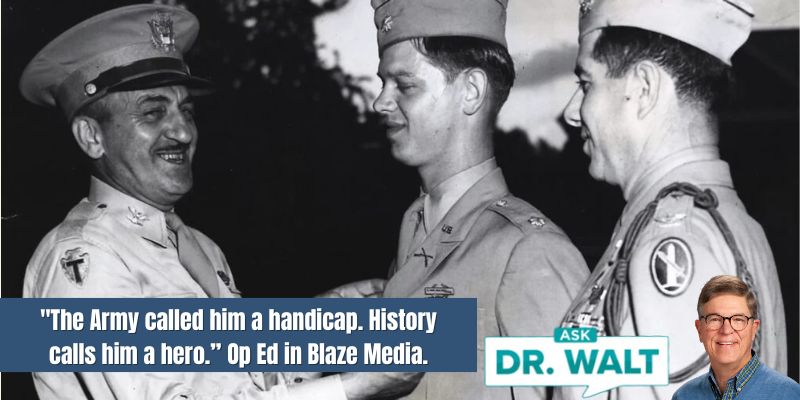
September 8, 1944 – Dad’s Bronze Medal exploits covered by newspaper articles back home
September 8, 2024
September 10, 1944 – A momentous and historic turning point in the European Battles of WWII
September 10, 2024September 9, 1944 – Troop fatigue was affecting both officers and men as casualties climbed
On 9 September General Butler, who had returned to his post as assistant VI Corps commander after Montelimar, noted the declining aggressiveness of the front-line troops and a tendency to rely more often on artillery and mortar fire in small combat engagements.[1]

This reluctance to close with the enemy—to rely more on firepower than on maneuver on the battlefield—was, he felt, a sign that the combat troops and especially their leaders were beginning to tire, psychologically if not physically.
By that time the VI Corps had advanced some 300 miles from its ANVIL assault beaches in just twenty-six days (Eisenhower’s SHAEF forces had taken ninety-six days to cover a similar distance) and the actual travel mileage was obviously much greater.
The 3rd Division’s command post, for example, had moved along some 400 miles of French roads on its way north from ALPHA RED to Besancon, and many other units, such as the 117th Cavalry Squadron, had covered even more ground.
According to one participant, the VI Corps headquarters units became so adept at moving that “those fellows could knock it down and, just like Ringling Brothers [Circus], set it up again” at a moment’s notice.
In the rear areas, the American and French advance northward had indeed been somewhat of a circus. Most Seventh Army soldiers had come on foot because of the critical shortage of trucks, which was aggravated by the continuing need to divert almost all vehicles to support the lengthening supply lines.[1]
~~~~~
In the French formations, de Lattre’s officers drafted civilian autos, river boats, horse carts, and any type of functioning captured vehicles that could further the movement of troops and supplies north.
Finally, although the SHAEF troops had certainly seen more fighting, they were also a larger force, able to distribute the rigors of the campaign over many more divisions; while in the case of the Seventh Army, most of the advance had been accomplished by a smaller number of units operating without respite.[2]
~~~~~
Thus, after pushing an average of ten miles per day, normally on foot, through German-defended territory, the forward infantry units of the Seventh Army had understandably begun to wear out as they approached the Belfort Gap and the Vosges Mountains.
Casualties also began to influence VI Corps’ effectiveness. As of the evening of 9 September the corps had suffered over 4,500 battle casualties (including 2,050 killed, captured, or missing) and some 5,300 nonbattle casualties.
Of the nearly 9,900 losses, about 2,900 men had been returned to duty; although the corps received around 1,800 replacements, it was short about 5,200, mostly infantrymen.
French casualties were slightly higher, although spread out over a greater number of units.20
With most of the Allied armies in both France and Italy in the same situation, there was general competition for infantry fillers that, for the time being, could not be fully satisfied except by cannibalizing new units or turning support units into rifle formations—solutions that had only adverse effects in the long run.
Weather was another important consideration. Inclement weather almost always penalizes the attacker by reducing the mobility of military forces.[3]
~~~~~
By 9 September the French autumn rains had begun in earnest; streams were rising, and cross-country movement was becoming progressively more difficult. Trails and dry-weather roads turned into quagmires, forcing most vehicles to rely on paved routes, many of which were deteriorating rapidly under heavy military traffic. In addition, the overcast weather reduced the amount of air support available, greatly limiting its ability to interdict German movements during September.
Terrain was also a factor, for by 9 September both the VI Corps and the French I Corps were well into hilly, often wooded ground that gave many advantages to the defense. The combination of all these factors–transportation, supply, fatigue, weather, and terrain–thus began to blunt the edge of the Seventh Army’s combat power, especially in the final drive toward the Belfort Gap.[3]
~~~~~
When troops … liberated a town in which was to be found a building equipped with every type of bath, including sulfur springs, The Division Special Services officer had an idea. Generators to power pumps were secured and connected and everything made ready. That night hundreds of tired, infantrymen came in from the woods and feels further first bath since arrival in France.[4]
~~~~~
[1] Msg, Butler to Truscott, 091900 Sep 44, Entry 100, VI Corps War Rm Jnl, 9 Sep 44. From: Clarke, 195.
[2] Robert F. Ensslin (a former VI Corps G-2 staff officer), “SOD Program,” MS (29 Sep 77), in Theodore J. Conroy Papers, MHI. Quoted in: Clarke, 196.
[3] Clarke, 195-197.
[4] Infantry Enjoys Hot Bath As Germans Abandon Town. Beachhead News. Souvenir Edition. Vol.1, No. 100. Sunday, October 15, 1944. Page 3.
In case you haven’t read or listened to Dad’s book, you can learn more or order it here.
© Copyright WLL, INC. 2024.



